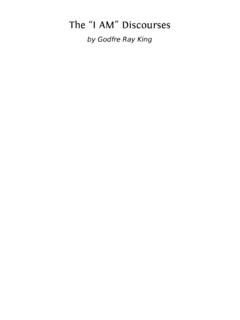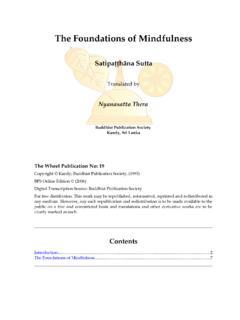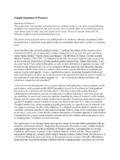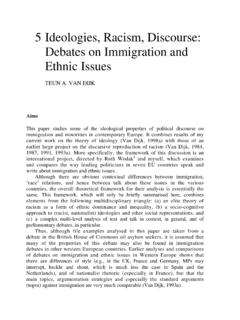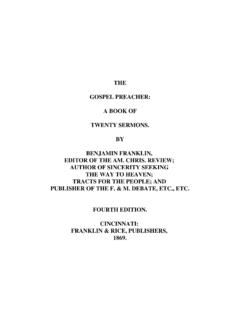Transcription of Notes on Spiritual Discourses of Shri Atmananda
1 Notes on Spiritual Discoursesof shri AtmanandaTAKEN BY NITYA TRIPTAP roposed second editionCONTENTSNote on the proposed second editioniiTransliteration schemeiiiPrefaceivForewordvMy indebtednessviIntroductionviiWhy such open talk?xOn the life sketch of the Sage, shri AtmanandaxiOn devotion to a living GuruxiiNotes on discourses1 Some Spiritual statements of shri Atmananda439 Life sketch of shri Krishna Menon ( shri Atmananda )466 Glossary490 Index499iiNote on the proposed second editionIn this proposed second edition of Notes on Spiritual Discourses of shri Atmananda ,there has been some minor editing (particularly of punctuation), to make the text Notes are now numbered in a continuous sequence throughout the book, insteadof the year by year numbering in the first edition.
2 (The original numbers are still givenin brackets at the end of each note title, however, to help with further proofing againstthe original.)The original subject war grouping before the main body of Notes has been re-placed by an index at the end. The reader should note, however, that the index refersto note numbers, not page added Notes , explanations and translations are given in square square brackets occur, the contents are added by the second edition editing work is not yet complete. In particular, some proofing remains to bedone; and some scholarly checking is further needed, of textual references and ofSanskrit and Malayalam further information or checking seems needed, this is indicated by (?) .iiiTransliteration schemeFor ordinary readers, a simplified transliteration has been used for Sanskrit and Ma-layalam names and even for the titles of cited texts.
3 But, for detailed quotations, amore exact transliteration has been used, for the sake of textual Sanskrit, the exact transliteration is the standard one, using the usual diacriticalmarks, except that e is written as e and o as o . This slight modification isneeded to have a common transliteration scheme which applies to both Sanskrit the simplified transliteration of Sanskrit characters, there are the following de-partures from standard academic practice: r is written as ri , v as ri , l as li , k as li , b as n or ng , as n or ny , z as sh , s as sh .For Malayalam characters that don t occur in Sanskrit, the following transliterationsare used: q is written as l . Thus, D v is written as ullil.
4 R is written as f . Thus, Fr u is written as Efuttacchan . s is written as c . Thus, As l is written as acivy . is written as gg . Thus, d is written as paggi .I apologize to Malayalam speakers for whom some of these usages will be I think that they are needed for the sake of those who do not know the ordinary reader, this scheme of transliteration is meant to indicate an ap-proximate pronunciation, even if the diacritical marks are ignored. However, it mayhelp to note that unmarked c , t and d are soft. In particular, c is pronounced like ch in chat ; and t and d are pronounced as in the Italian pasta and dolce . Bycontrast, t and g are pronounced more like the hard t in table , and d like thehard d in donkey.
5 Where h occurs after a preceding consonant, it does not indi-cate a softening of the consonant (as it may in English). Instead, it indicates an aspi-rated sound that occurs immediately after the of proposed second edition, May 2006ivPrefaceThough I have been closely attached to shri Atmananda Guru ever since 1927 (when Iwas accepted as his disciple and initiated), it was only in November 1950 that I madebold one day at the instance of a distinguished friend of mine to make an attemptto take some Notes on that day s talk, which had been particularly compelling. Thefriend left the same night. I wrote down the Notes the next day and most hesitatinglysubmitted them at Gurunathan s feet, to see if they could be sent to the gladly ordered me to read them and I obeyed rather nervously.
6 He listened tothem patiently, and suggested some small deletions to avoid controversy. At the end,he asked me with a luminous smile on his face: How did you do this? I humblyreplied, I do not know , and told him the circumstances. He laughed, and said: I ampleased with them. You may send them to her and also continue the practice. I realized immediately how I was a simple tool at the merciful hands of the Abso-lute, and prostrated at his feet. He blessed me with both hands, and I stood up in encouraged and enriched, I continued the practice till the middle of April was how these Notes came to be. Subsequently, they were twice read out toGurunathan [ shri Atmananda ] himself, and finally approved by him as true to hisexposition, both in idea and in intended originally for the benefit of the disciples alone, who already hadreceived directly from him the fundamentals of his exposition, they are now printedand published for the benefit of the general public as well.
7 They have been found tobe helpful to all those who have acquired at least a modest acquaintance with hismethod of direct approach to the ultimate preliminary knowledge of his book Atmanandopanishad in two parts, sepa-rately called Atma-darshan and Atma-nirvriti is almost indispensable for under-standing these Notes , not only for those who have had no direct contact with ShriAtmananda Guru, but also for those who are already his word too has to be said about the English language used here. Born in a differentclimate and designed to describe experiences somewhat different from those obtainingin Spiritual India, the English language (now almost an international language) hasperforce to undergo certain local modifications of idiom and punctuation.
8 Sometimes,a bold departure from the accepted usage of a word or a phrase could alone yield theright meaning of Vedanta. Such departures are inevitable, and they give force to theideas and enrich the was insisting upon me ever since 1956 to print and publish these Notes . It re-quired a lot of time to compile and edit them. I was proudly privileged to utilize allmy available time for direct services to his person. I was reluctant to divert any part ofmy time to other work which could well afford to wait. Therefore I could not take upthis work of publication till he passed away. If any mistakes of expression or of anyother kind have slipped into these Notes without his knowledge, I am solely responsi-ble. All the rest belongs to my Guru, the Truth.
9 *(Nitya Tripta) *A word of caution in this context has become necessary. There are other persons and sannya-sins of different orders known by the identical name Atmananda . Let not the views or writ-ings of any of them be mistaken for those of shri Atmananda of NOTE TO THE READERSThe subject matter of this book being Notes of Discourses , certain conversationalmannerisms, peculiar usages, repetitions etc. though not strictly literary havenecessarily been retained. Their force, freshness and naturalness appeal particularly tothose who have listened to the Discourses had to fight against odds in this maiden enterprise of mine in the field of publica-tion, and I am conscious of the innumerable imperfections and oversights that havecrept into these pages.
10 Therefore, as an immediate remedy, I have added just a modesterrata at the close of every year, for such mistakes alone that affect the sense imperfections can be rectified only in the next subject war grouping and tabulation of the titles by numbers added after the con-tents would enable the reader to have an exhaustive idea of any particular topic when-ever necessary. [In this second edition, the subject war grouping is replaced by anindex, at the end of the volume.]A glossary is added towards the end of the volume, in alphabetic order, giving sim-ple Advaitic explanations of the important technical and philosophical terms andexpressions occurring in the course of the list of about five hundred of shri Atmananda s Spiritual statements (collectedfrom these talks and from elsewhere, and added towards the end of the volume) willbe particularly useful to those who had any direct contact with him, and will feed thespiritual inquisitiveness of many a thinking list of the original Sanskrit quotations referred to in the course of the talks isadded in Sanskrit script at the end of the volume and the particular number is givenfor reference at the places where it is mentioned.

